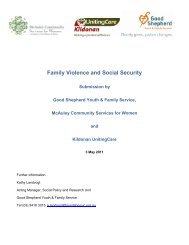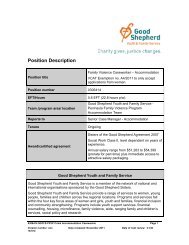Spotlight on economic abuse - Good Shepherd Youth & Family ...
Spotlight on economic abuse - Good Shepherd Youth & Family ...
Spotlight on economic abuse - Good Shepherd Youth & Family ...
You also want an ePaper? Increase the reach of your titles
YUMPU automatically turns print PDFs into web optimized ePapers that Google loves.
Exploring the impacts of ec<strong>on</strong>omic <strong>abuse</strong><br />
Referring to the Australian c<strong>on</strong>text, Brookes has observed:<br />
there has been little research to understand how (ec<strong>on</strong>omic <strong>abuse</strong>) is used,<br />
how it is experienced by women, its role in c<strong>on</strong>trolling and manipulating<br />
women, in creating dependence and isolati<strong>on</strong>, in obstructing women’s escape;<br />
and its l<strong>on</strong>g-term impact <strong>on</strong> women even after leaving the relati<strong>on</strong>ship.<br />
(Brookes 2006, p. 2)<br />
A scan of the literature suggests this c<strong>on</strong>tinues to be the case and also that there is very<br />
limited research which has specifically examined the impacts of ec<strong>on</strong>omic <strong>abuse</strong> <strong>on</strong> women,<br />
children, families and <strong>on</strong> the community. However, much is known about the impacts of the<br />
domestic and family violence of which ec<strong>on</strong>omic <strong>abuse</strong> is <strong>on</strong>e element. In additi<strong>on</strong> it is not<br />
always possible or sensible to try to disentangle the impacts of <strong>on</strong>e form of violence from the<br />
impacts of other forms of violence. As illustrated earlier, ec<strong>on</strong>omic <strong>abuse</strong> and other forms of<br />
violence occur together and overlap as part of patterns of c<strong>on</strong>trolling behaviour; this is also<br />
likely to be the case for the impacts of violence as indicated in the model presented in Figure<br />
One. Domestic and family violence can have significant negative c<strong>on</strong>sequences for<br />
ec<strong>on</strong>omic wellbeing whether or not an abusive partner’s behaviour includes ec<strong>on</strong>omic<br />
<strong>abuse</strong>. At the same time, ec<strong>on</strong>omic <strong>abuse</strong> leading to financial hardship potentially has a<br />
whole range of negative c<strong>on</strong>sequences for health, housing, employment, interpers<strong>on</strong>al<br />
relati<strong>on</strong>ships and parenting while these factors can also impact <strong>on</strong> children’s wellbeing.<br />
Some of the direct and most apparent c<strong>on</strong>sequences for victims of ec<strong>on</strong>omic <strong>abuse</strong> are the<br />
financial or ec<strong>on</strong>omic c<strong>on</strong>sequences. These are c<strong>on</strong>sequences for people while they are in<br />
violent relati<strong>on</strong>ships, <strong>on</strong> leaving violent relati<strong>on</strong>ships, when attempting to gain financial<br />
stability following exit from violent relati<strong>on</strong>ships and <strong>on</strong> their prospects for ec<strong>on</strong>omic security<br />
in the l<strong>on</strong>g term.<br />
As Outlaw (2009, p. 264) puts it “(e)c<strong>on</strong>omic <strong>abuse</strong> involves imposed ec<strong>on</strong>omic dependence<br />
of the <strong>abuse</strong>d by the <strong>abuse</strong>r, if not outright stealing by the abusive spouse”. Ec<strong>on</strong>omic<br />
dependence <strong>on</strong> an abusive partner can be a critical obstacle to leaving the relati<strong>on</strong>ship<br />
(Adams et al. 2008). In additi<strong>on</strong> to victims being unable to access funds needed to leave,<br />
domestic violence can cause social isolati<strong>on</strong> which reduces opti<strong>on</strong>s for leaving<br />
(ALRC/NSWLRC 2010). However, while c<strong>on</strong>cerns about financial insecurity—including<br />
c<strong>on</strong>cerns for impacts <strong>on</strong> children—are <strong>on</strong>e reas<strong>on</strong> women stay in abusive relati<strong>on</strong>ships,<br />
financial issues have also been identified as providing the impetus for women to leave<br />
abusive relati<strong>on</strong>ships (Braaf &Barrett Meyering 2010).<br />
Ec<strong>on</strong>omic <strong>abuse</strong> threatens short and l<strong>on</strong>g-term ec<strong>on</strong>omic wellbeing. Women <strong>on</strong> low incomes<br />
in a relati<strong>on</strong>ship with an abusive partner report a lack of resources needed for day-to-day<br />
survival such as m<strong>on</strong>ey, housing, childcare and transportati<strong>on</strong> (Adams et al. 2008; Power<br />
2006; Short et al. 2000). Abuse can impact <strong>on</strong> women’s capacity to work leading to<br />
interrupted employment and to unemployment (Lindhorst et al. 2007; Lloyd 1997; Swanberg,<br />
Macke and Logan 2007).<br />
In Australia, domestic and family violence is often associated with poverty and<br />
homelessness (Australian Institute of Health & Welfare [AIHW] 2007; Branigan 2004) and,<br />
while financial hardship prevents some women leaving abusive relati<strong>on</strong>ships, it also<br />
sometimes prompts women to return. Lack of m<strong>on</strong>ey can limit women’s capacity to access<br />
services needed to support recovery and prevent women taking up safety measures such as<br />
installing locks and alarms, maintaining a ph<strong>on</strong>e and a car or relocating (Braaf & Barrett<br />
Meyering 2011).<br />
18









